- Microscopes
- Cameras
- Lab Supplies & Equipment
- Shop By Brand
- Lab Supplies by Category
- Analyzer Consumables
- Balances
- Bags
- Beakers
- Bench Scale Bases
- Bottles
- Bottletop Burettes
- Bottletop Dispensers
- Boxes
- Blank Microscope Slides & Cover Slips
- Blood Collection
- Caps
- Carboys
- Centrifuges
- Centrifuge Tubes
- Cold Storage
- Containers
- Cryogenic Vials
- Culture Tubes
- Cylinders
- Dispensers
- Digital Dry-Baths
- ESR Products
- False Bottom Tubes
- Flat Bottom
- Funnels
- Gel Documentation
- Glassware
- Glass Test Tubes
- Histology
- Homogenizers
- Hotplates-Stirrers
- Inoculation Loops and Spreaders
- Liquid Handling Products
- Manual-Electronic Pipettors-Pipettes
- Microscope Slides
- Overhead Stirrers
- Pipette Controller (Serological Filller)
- Pipette Tips
- Plastic Test Tubes
- PCR Tubes, Strips & Plates
- Racks
- Repeater Pipettor
- Rockers
- Rotary Evaporators
- Serological Pipettes
- Shakers
- Spectrophotometers
- Syringe Tips
- Sample Tubes
- School/Classroom Supplies
- Screwcap Test Tubes
- Self-Standing
- Test Tube Racks
- Test Tubes & Vials
- Transport & Storage Tubes
- Thermal Mixers
- Transfer Pipets
- Urinalysis
- Vacuum Pumps
- Weighing Dishes
- Lab Equipment
- Balances
- Bench Scale Bases
- Centrifuges
- Digital Dry-Baths
- Gel Documentation
- Homogenizers
- Hotplates-Stirrers
- Overhead Stirrers
- Pipettors
- Rockers
- Rotary Evaporators
- Shakers
- Serological Pipettes
- Spectrophotometers
- Thermal Mixers
- Vacuum Pumps
- Liquid Handling Products
- Manual-Electronic Pipettors-Pipettes
- Pipette Tips
- Racks
- Pipette Fillers-Controllers
- Repeater Pipettor
- Syringe Tips

Cost effective products and solutions designed to improve laboratory efficiency, safety and results.
SHOP BENCHMARK SCIENTIFIC >
- Slides & Accessories
- Slides
- Cameras
- Illuminators
- Adapters
- Eyepieces / Objectives
- Bulbs
- Magnifying Lamps
- Monitors and Tablets
- View All Categories
- Adapters
- DSLR Adapters
- USB Camera Adapters
- Ring Light Adapters
- Power Adapters
- Barlow Lens
- Books & Experiments Cards
- Bags & Cases
- Bags
- Cases
- Cameras
- Circuit Board Holders
- Cleaning Kits
- Condensers
- Darkfield
- Phase Contrast Kits
- Polarizing Kits
- Dust Covers
- Eye-Guards
- Eyepieces
- 20mm
- 23mm
- 30mm
- 30.5mm
- Filters
- Microscope Filters
- Illuminator Filters
- Fluorescence Kits
- Conversion Kits
- Filter Cubes
- Focusing Racks
- Fuses
- Illuminators
- Bulbs
- LED Illuminators
- Fiber Optic Illuminators
- Fluorescent Illuminators
- Ring Lights
- Stand Lights
- Goosenecks
- Gooseneck Attachments
- Immersion Oils
- Loupes
- Magnifying Lamps
- Clamp Lamps
- Desktop Lamps
- Rolling Stand Lamps
- Mechanical Stages
- Monitors and Tablets
- Calibration Slides & Stage Micrometers
- Stage Warmers
- Stain Kits
- Stands
- Articulating Arm Stands
- Boom Stands
- Table Stands
- Tweezers
- Other Accessories
- Shop By Industry
- Shop By Industry
- Botany
- Agronomy & Forestry
- Horticulture
- Phytopathology
- Chemistry
- Biochemistry
- Biotechnology
- Cannabis
- Pharmaceutics
- Consumables
- Beer & Wine
- Cosmetics
- Food & Beverage
- Electronics
- Circuit Boards & General Electronics
- Mobile Phone Repair
- Semiconductors & Wafers
- Environmental
- Asbestos
- Ecosystem Research
- Mud Logging
- Soil Treatment
- Water Treatment
- Forensics
- Ballistics
- Fingerprint Analysis
- Genetic Identification
- Hair & Fiber Analysis
- Handwriting Analysis
- Industrial
- Aerospace
- Automotive
- Dental Lab & Production
- Glass Industry
- Industrial Inspection
- Mechanical Parts
- Paper Industry
- Petrochemical
- Plastics
- Printing Industry
- Quality Assurance & Failure Analysis
- Textiles & Fibers
- Tool Making
- Wood Production
- Jewelry & Gemology
- Engraving
- Gemology
- Jewelry Repair
- Stone Setting
- Watch Repair
- Hobby
- Coins & Collecting
- Stamps
- Modeling & Assembly
- Sculpting
- Repair
- Telescopes
- Metallurgy
- Archaeology
- Geology
- Mining
- Petrology
- Medical & Microbiology
- Anatomopathology
- Bacteriology
- Biochemistry
- Cell Culture
- Cytology
- Dental Microbiology
- Dermatology
- Dissection
- Gout & Rheumatology
- Hair & Fiber Analysis
- Hair Transplant
- Fluorescence
- Hematology & Live Blood Analysis
- Histopathology
- Mycology
- Medical Devices
- Microsurgery
- Neuropathology
- Oncology
- Parasitology
- Pathology
- Semen Analysis
- Virology
- Veterinary & Zoology
- Breeding & Semen Analysis
- Entomology
- Fecal Smears & Floats
- Marine Biology
- Ornithology
- Veterinary Medicine
- Zoology
- Shop By Industry
- Students
- Telescopes
- Buy With Prime
- Sale
- Compound Microscopes
- Shop By Brand
- AmScope
- Euromex
- Omax
- Shop by Head Type
- Binocular
- Monocular
- Trinocular
- Multi-head & Training
- Shop By Specialty
- Brightfield
- Darkfield
- Phase Contrast
- Inverted
- EPIfluorescence
- Polarizing
- Digital Integrated
- Metallurgical
- Shop By Application
- Education
- Research
- Veterinary
- Compound With Digital Head
- Shop Best Sellers
- Shop All Compound
- Stereo Microscopes
- Shop By Brand
- AmScope
- Euromex
- Shop By Objective Type
- Fixed Power
- Zoom Power
- Single Lens
- Common Main Objective
- Shop By Stand Type
- Articulating Arms
- Boom Stands
- Gooseneck Stands
- Table Stands
- Other Stands
- Shop By Head Type
- Binocular
- Monocular
- Trinocular
- Simul-Focal
- Shop By Industry
- Video Inspection
- Industrial Inspection
- Microscope Heads
- Shop Stands
- Articulating Arm
- Boom Stands
- Table Stands
- Stereo With Digital Head
- Shop Best Sellers
- Shop All Stereo
- Specialized Microscopes
- Digital Microscopes
- Kids, Student Microscopes
| AmScope Blogs
Budget Microscopes: Quality Microscopes at Deep Discount Prices
Buying a microscope is a significant investment, whether you plan to use it for professional, educational, or hobby purposes. You can't always go by price alone when judging the quality of a microscope, but very cheap microscopes aren't likely to be high quality. Lenses, lighting, and the body of a quality microscope must be constructed of quality materials, which can get costly.
However, there are ways you can buy a quality microscope at a discount price. In this article, we'll talk about what features you should look for in a quality microscope as well as how you can find a good deal on one.

What To Look For in a Quality Microscope
There are several key features you should look for in a quality microscope, regardless of your budget. Whether you're in the market for a student-grade or a professional microscope, look for the following:
Quality Optics for Clear Imaging
Optics are the most important part of a microscope. The objective lenses on your microscope should be labeled with one of two standards, Deutsche Industrie Norm (DIN) or infinity. Most microscopes that sell for under $1000 use DIN objectives. Infinity objectives are becoming more common, but they're usually found on professional-grade microscopes.
Ensuring your microscope uses one of these two standards guarantees that:
- You can replace your lenses if one breaks
- The color correction of your lenses will be accurate
Another important lens is the eyepiece. It's also called the ocular, and it's the lens that's closest to your eye. Your microscope may offer you the option to change your eyepiece. If it doesn't, make sure the one you choose has a wide field of view. The standard size of a wide-field eyepiece is 18 mm.
A wide-field eyepiece makes it easier to see through your microscope. It also widens your field of view so you won't have to move your slide around as much. A wide-field eyepiece is particularly important if children will be using the microscope. It won't be as fiddly, and they'll be able to see more.
Finally, you can buy microscopes that are either monocular or binocular. Monocular microscopes only have one eyepiece, while binocular microscopes have two. This is largely a matter of personal preference, although you should consider how you'll be using the microscope. If you're going to be using the microscope for long periods, you may want the comfort of using a binocular microscope.
AmScope offers great deals on both monocular microscopes and binocular microscopes.
While it may seem like a binocular microscope would be easier for children to use, they may actually have more success using a monocular microscope. Young children may have a harder time adjusting a binocular microscope.
Quality Materials
You can tell a lot about the quality of a microscope by examining the materials used to construct it. Microscopes that are made of heavy metal will be more durable than microscopes made of lightweight plastic. Check to see if the gears, frame, and screws are metal.
Lighting
Another feature that affects the quality of a microscope is the lighting. Microscopes usually come with one of four types of lighting:
- Tungsten
- Fluorescent
- Halogen
- LED
LED lighting is the best option in most cases. LED bulbs are energy-efficient, cool, and bright. There is a danger that an LED light can be too bright, so a dimmer switch is a valuable feature on an LED microscope.
Fluorescent lighting is an acceptable option. Fluorescent bulbs are still fairly white for clear viewing and are usually cool enough not to harm your specimen.
You should avoid microscopes that use tungsten lighting. Tungsten or incandescent bulbs are hot and yellow. It's also difficult to find replacement bulbs for tungsten lights.
Halogen lighting used to be a standard feature on lab-quality and research microscopes before LED lighting became more common. Halogen light is very bright and concentrated. It's rarely used now, but if you find one, it will probably come equipped with a dimmer to help reduce the heat.
A Guarantee
The industry standard is a five-year guarantee. AmScope stands behind all its microscopes, so you can rest easy knowing you won't get stuck with a poor-quality microscope.

Discount Options for Budget Microscopes
Since buying cheap microscopes won't provide you with a quality product, you'll need to look for other ways to save money. Some legitimate ways you can save money on discount microscopes include:
Open-Box Microscopes
AmScope offers steep discounts on open-box products. These are microscopes that are fully functional and new except that they have been opened. You get all the quality of a new microscope at a significant price reduction.
Clearance Microscopes
You can get excellent deals on clearance microscopes. These are top-quality microscopes at discounts of up to 44%. Clearance microscopes are new microscopes that are usually on sale because they were overstocked.
Final Thoughts
Buying a microscope doesn't have to break the bank. When you know what features to look for in a quality microscope and where to find good deals, you can find value microscopes for any need. You can avoid buying a low-quality microscope by examining the overall construction. Look for a microscope made of metal, and check to see that the optics are high quality, including the objective lenses and eyepieces. You should also check the lighting source and opt for LED lighting if possible.
When you're looking for a good value, try looking in the clearance section or the open-box section. You'll be better off choosing a quality microscope that has been discounted rather than choosing cheap microscopes from an unreliable company.
AmScope offers a wide variety of microscopes for every application, from student-grade to research quality. When you order with AmScope, you'll get a customer satisfaction guarantee, a price match, and a five-year warranty. With AmScope, you'll get microscopes for less without compromising quality. AmScope has been the top source of microscopes for over 15 years. Our microscopes are used in laboratories, research facilities, universities, and businesses all over the world.
Free Shipping on orders $149+
Same day shipping for orders within the contiguous U.S.
Easy Returns
Hassle-free 30-day return policy. 100% satisfaction guarantee.
Quality Products
5-year warranty on AmScope microscopes.
Got a question?
Speak to our team of experts and find the products you need.
















